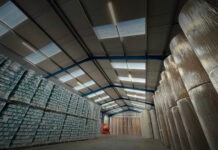China’s National Household Paper Industry Association has urged its companies to invest “rationally” in its annual assessment of the current status of the industry. TWM’s report highlights the main points, and weighs its projections against wider industry trends.
Just how its tissue industry has been impacted by three years of extreme challenges is made clear in the ‘China Tissue Pulse’ report by China’s National Household Paper Industry Association (CNHPIA). Last year was a challenge as businesses tackled residual effects of the pandemic as well as international crises, pulp prices, historical high energy costs, production disruption, poor logistics, and an over-reliance on imports.
Profit margins were significantly reduced and accelerated the industry reshuffle. Enterprises strove to break through with advanced technologies, new products, strengthened brands and marketing innovation. Fierce market competition and more new projects resulted in more “staged overcapacity” becoming increasingly serious.
In its assessment CNHPIA makes various calls for action, including: companies investing “rationally;’ government acting on tax and fee cuts; more green logistics channels; equipment enterprises to innovate and export; develop differentiated products; launch more energy-saving and carbon-reducing equipment and products and realise the collective development of the industry through production capacity cooperation and supply chain cooperation between enterprises. TWM presents a summary of the report’s main points.
Part One: 78 tissue machines put into operation across the country
According to the data of the National Household Paper Industry Association (CNHPIA), the total new capacity for the Chinese tissue market reached nearly 1.927 million tons in 2022. The new capacity is less than that of 2021 but already exceeds that of 2020 and 2019. A total of 36 companies in 16 provinces launched new capacity, while 78 tissue machines were put into operation in total. This compares to 2021, when 62 companies were reported launching new tissue capacity in 16 provinces in 2021 and 112 tissue machines were put into operation.
Domestic tissue machines dominated in the new capacity and were mainly concentrated in large and medium-sized enterprises. The new capacity is mainly located in Jiangsu, Guangxi and Hebei. The main projects of major companies include: Gold Hongye, C&S, Lee & Man, Liban and Botare.
Major projects of top enterprises:
Rudong: 480,000tpy
Hebei: 30,000tpy
Jiangxi: 56,000tpy
Guangxi: 60,000tpy
Xiaogan: 25,000tpy
Jiangxi: 140,000tpy
Guangxi: 70,000tpy
Zhejian: 120,000tpy
Hunan: 160,000tpy
Guangdong: 100,000tpy
Capacity investment plan of leading enterprise
In addition to the launched capacity, many new capacity expansion projects have been signed in 2022. The new capacity announced by top companies such as Hengan, Gold Hongye, C&S,Libang and Rain Forest and new companies to the industry such as Asia Symbol and Liansheng Paper that have signed up for tissue machines or have determined the tissue machine type totalled 2.785 million tpy.
Part Two: declining revenue capacity of industrial enterprises
Performance of listed companies (all figures for 2022):
Hengan: First half sales revenue of Hengan Group’s tissue paper business increased significantly by nearly 25% to about 5.843bn yuan, accounting for about 52.2% of the overall revenue. The gross profit margin of the group’s tissue business decreased to approximately 23.1%.
Vinda: First three quarters total revenue increased by 6.6% (8.8% at constant currency) to HK$14,055 million, of which HK$11,562m came from the tissue business.
C&S: First three quarters operating income (mainly tissue paper) was 6.114bn yuan, a year-on-year decrease of 2.56%, and the net profit attributable to shareholders of listed companies was 275m yuan, a year-on-year decrease of 43.33%. From the operating data in quarterly performance reports released by Hengan, Vinda and C&S, their gross margins or net profits declined. This reflects to a certain extent the impact of the huge increases in pulp prices, disruptions in production, poor logistics caused by Covid-19, and weak consumer market demand and increasing market competition.
Small and medium-sized enterprises also saw a declined. In 2022 the overall start-up rate of tissue enterprises in the region was less than 70%, and was as low as 40% to 50% in June to August. The manufacturing enterprises were generally in a staged loss, and slowed down the project investment. Here too, the sharp rise in pulp prices, price inversion of pulp and paper, and overcapacity have made the year very difficult. In Baoding, for example, where small and medium-size enterprises are most concentrated, 2022 saw an overall start-up rate of paper enterprises less than 70%, and was as low as 40% to 50% in June to August. The companies were generally in a staged loss and slowed down the project investments.
Part Three: changes in raw material and product prices
According to data from Chinese customs, the price of imported pulp was generally on the rise in 2022, and from August to September 2022 rose to an all-time high in nearly 10 years. The average price of imported bleached softwood pulp and hardwood pulp reached about USD 990/ton and USD 805/ton, respectively, a significant increase of 29.6% and 41.7% from the prices of about USD 764/ton and USD 568/ton in February 2022, the lowest value of the year.
Non-wood pulp prices rose substantially
Due to the increase in the price of imported market pulp, the overall price of bamboo pulp and bagasse pulp also continued to rise. The average price of bleached bamboo pulp in Sichuan and bleached bagasse pulp in Guangxi rose from 5,300 yuan/ton and 4,825 yuan/ton in January to 7,000 yuan/ton and 5,625 yuan/ton at the high point in October, up 32% and 17%, respectively. Tissue parent roll prices also rose. Bleached pulp tissue parent rolls produced in Hebei increased on average from 6,700 yuan/ton in January 2022 to 8,550 yuan/ton at the high point in October, up 27%, which is lower than the price increase of imported market pulp. The figures show the difficulty in passing rises in raw material price on to the end products. Business operations are under huge pressure, and zero profit and loss become common situation.
Part Four: product upgrade and innovation
Advances were concentrated in two production streams
The first developed differentiated products through new technologies and new equipment to improve the performance of products in use. For example, the launch of products with better bulkness through new tissue machine technology and converting machines. Mind Act Upon Mind launched the cloud series tissue, Vinda launched cashmere sensory series toilet roll, and Virjoy launched hot air through kitchen towels with the TAD technology.
Apply new technologies and equipment to improve product performance
Libang, Rain Forest, Golden Doctor and Botare have also launched newly upgraded 3D embossed tissue.
In addition, lotion tissue is also a relatively fast-growing product category in the past two years. In 2022, enterprises also continued to put emphasis on this product category and launched new products. For example: Mind Act Upon Mind, C&S, Hygienix, Babo launched soft lotion tissue, and so on.
The second aspect of product upgrade and innovation was the enhancement of cultural attributes and environmental protection concepts of products through brand marketing.
Brand positioning examples included:
Vinda created a new IP “Lamb Weiwei”.
C&S joined hands with people.cn to create a new IP of CHINA Face, and launched a co-branded Chinese New Year gift box with people.cn.
Hengan launched a new Jimmy series of Mind Act Upon Mind handkerchief tissue.
Breeze launched tissues under two new IP.
Hulijia launched the CQ-show toucan series and the peony series tissue.
Additionally, Virjoy launched zero-carbon tissue, Breeze launched its first away from home zero-carbon jumbo roll tissue, and Babo launched the Ocean Protecting series handkerchief tissue.
Part Five: new equipment and technology
Imported high-end tissue machines were introduced into China to promote the upgrading of production capacity in the domestic market, the latest technology TAD technology included in that upgrade. Hengan introduced two more Valmet Hybrid tissue machines, mainly for the production of high-quality facial tissue and kitchen towels. Before that, Hengan had introduced two Toscotec TAD tissue machines, which are scheduled to be put into operation in 2023.
Vinda has successfully put four Valmet Hybrid tissue machines into operation to produce differentiated tissue products. At the same time, Andritz’s TEX TAD-like tissue machine and Toscotec’s INGENIA TAD-like tissue machine were also actively promoted.
Low-carbon equipment, automated equipment, and remote technology were also brought on stream:
Qingliang launched the expert remote detection system.
Hangzhou MCN improved the operating efficiency of headbox through an automation control system developed by the company.
Toscotec introduced the inductive Steel Yankee Dryer that uses electrical induction instead of steam to dry paper, thereby reducing direct greenhouse gas emissions to zero.
Additionally, new converting machine technology in China includes:
Baosuo launched the automatic draw-out facial tissue converting machine with the characteristics of energy saving, low consumption, high efficiency and low production costs.
Dechangyu continued to work on embossing and printing solutions, and widened the use of its technology based on rich pattern design and technical solutions.
One Paper launched the log saw cutter, which is capable of automatically measuring length and equalizing and suitable for plastic-pack facial tissue packaging, thereby greatly reducing waste.
IMAKO launched the plastic-pack facial tissue converting line, which is capable of switching products sizes at will, and automatically packing and stacking with robots.
OK Technology developed and launched the facial tissue folding line specially designed to use with TAD tissue machine for Hengan, and also started up several converting machines with the max width in China for production of plastic-pack facial tissue, handkerchief tissue and hand towel.
In December OK Technology was successfully listed on the A-share market, becoming the first listed tissue paper converting machines manufacturer in China.
Part Six: import and export markets
Tissue paper imports and exports in the first three quarters of 2018 to 2022
At present, output and product types meet the needs of consumers, while exports dominate with imports at a low proportion in the domestic market. In recent years the annual import tissue paper volume was between 28,000 to 50,000 tons, a relatively small number and has little impact on the domestic market. The first three quarters of 2022 saw volume and value reduced year-on-year to about 24,300 tons. Parent roll dominated, accounting for 83.4%.
In the same period, export volume and export value showed double-digit growth. Volume was 564,400 tons, up 19.46% year-on-year, and value was about USD 1.389bn, up 31.66% year-on-year. Export volume of finished paper accounted for 76.72% of the total export volume of tissue paper products. The export value of finished paper accounted for 86.91% of the total export value, and the proportion showed an upward trend year by year.
Sector variations show: the proportion of toilet tissue is decreasing, the proportion of handkerchief tissue and facial tissue is increasing, and the export volume is 191,000 tons, which exceeded that of toilet tissue for the first time in nearly three years, indicating that the structure of exported tissue continued to develop towards high-end level.
Part Seven: release and implementation of relevant standards
Certain national standards and group standards were released or started to be implemented in 2022, as well as the standards under revision. Among them, the group standard “Products with Craftsmanship — Tissue Paper”, with the China National Pulp and Paper Research Institute (CNPPRI) taking the lead in drafting. The release of this standard has an important guiding significance in improving the quality of tissue products and meeting consumers’ demand for consumption upgrading.
Newly released national standards include:
GB/T40358—2021 Toilet Tissue Paper and Hand Towel—Specification for the use of recycled fibre, Issued on August 20, 2021 and implemented on March 1, 2022
GB/T 20808—2022 Facial Tissue, Issued on April 15, 2022 and implemented on May 1, 2023
GB/T 24455—2022 Hand Towel, Issued on July 11, 2022 and implemented on August 1, 2023
GB/T 26491—2022 Toilet Seat Paper, Issued on July 11, 2022 and implemented on August 1, 2023.
Newly released group standards include:
T/CTAPI 002—2022 Products with Craftsmanship — Tissue Paper, Issued by China Paper Association on April 21, 2022 and implemented on May 1, 2022
T/CDZX 002—2022 Soft Moisturizing Facial Tissue, Issued on March 5, 2022 and implemented on March 30, 2022
Newly released industry standards
QB/T 57422—2022 Natural Colour Pulp, Issued on April 24, 2022 and implemented on October 2, 2022
Standards that are being revised
Kitchen wipes.
Part Eight: action towards the “Dual Carbon” goal
In September 2020, China put forward the development strategy of “Dual-Carbon Target”, striving to reach the peak of carbon dioxide emissions by 2030 and achieving carbon neutrality by 2060.
Tissue companies which have started to layout such developments include:
Hengan Group’s factories in many places have achieved solar energy in the whole plant, with an annual power generation of 2,000kWh and a carbon emission reduction of 8,688tpy. The steam, natural gas, water, electricity consumption per ton of paper is far lower than the industry average.
Hengan Group’s factories in many places have achieved solar energy in the whole plant, with an annual power generation of 2,000kWh and a carbon emissions reduction of 8,688tpy. The steam, natural gas, water and electricity of per tons of paper is far below the industry average.
All Gold Hongye Paper mills have currently obtained CFCC/PEFC forest certification. The company has taken the lead in launching zero-carbon tissue series and has been actively promoting the certification in green supply chain, green factory, and so on.
CNPPRI successfully organised the occupation training and occupational ability evaluation for carbon emission managers to promote green and low-carbon transformation development and help achieve the Dual-Carbon goal.
Part Nine: brand building and marketing channel innovation
Another development was the practice the National Strategy of “Increase Variety, Improve Quality and Innovate Brand”. CNPPRI actively built the brand cultivation service platform for the tissue paper and hygiene products industry, and carried out relevant work to evaluate “Products with Craftsmanship” in the industry.
Among them, products of Vinda, Breeze, C&S, Hygienix, Libang and Rain Forest listed in the first batch of “Products with Craftsmanship” in the industry.
Compared with general products, products with craftsmanship are of superior quality, safer to use and better able to meet consumers’ needs for consumption upgrading.
Expansion of new marketing methods included:
Mind Act Upon Mind made full use of resources on Douyin.
Vinda and Meituan Youxuan created a super brand day and conducted cooperation on new product marketing with Global Leap.
Breeze launched the “Green Breeze Discovery” consumer interactive activity.
C&S launched a live online show in cooperation with Xinhua Net and Z-PIN.
Part Ten: current issues facing the industry – and thoughts
Co-ordinated actions needed to steer the industry through the challenges
In recent years China’s tissue paper capacity has been increasing at a faster pace. Although investment in new projects slowed down in 2022, the problem of staged overcapacity is becoming more serious. CNHPIA reports that this has been followed by a continuing decline in operating rate. It expects 2022 figures will also show a fall. It urges companies to invest “rationally.”
In its conclusions, the CNHPIA reports:
Spiked raw material price and accelerated market competition.
The market pulp used in China’s tissue paper industry is highly dependent on imports. Affected by the continued spread of global the Covid-19 pandemic and the international logistics, the price of imported pulp hit a new record high in 2022.
At the same time, due to overcapacity in the industry, fierce market competition, and a decline in market consumption caused by Covid-19, it is difficult to raise the selling price of products, profit margins of tissue manufacturers are significantly reduced.
Impact of Covid-19 outbreaks: in 2022, due to the pandemic outbreaks the operation of manufacturing enterprises was seriously affected, and production disrupted. At present, with the further adjustment of the prevention and control policy, the resumption of work and production of companies has been improved and the logistics in various regions is gradually being restored.
The operating pressure of equipment suppliers has increased.
Due to the impact of Covid-19 and overcapacity, domestic tissue companies slowed down their investment in new projects, resulting in a decrease in the orders of tissue machines and converting machines.
At the same time, the problems facing the international market include high shipping prices, difficulties in offline communication between equipment suppliers and customers, and difficulties in timely arrival of project service personnel, which made it difficult to carry out orders.
Calls for government action.
In November 2022, China National Pulp and Paper Research Institute and CNHPIA actively reported the difficulties encountered by enterprises to relevant government departments and called for the introduction of tax and fee cuts, providing special loans and interest rate concessions, opening up green logistics channels, encouraging equipment enterprises to innovate and export. With the adjustment of pandemic prevention and control requirements and relevant policies, enterprises have gradually resumed their production and operation.
At the same time, the CNHPIA also suggests that enterprises in the industry actively research, innovate and develop differentiated products to enhance brand competitiveness and avoid price competition, launch more energy-saving and carbon-reducing equipment and products, and realise the collective development of the industry through production capacity cooperation and supply chain cooperation between enterprises.

































